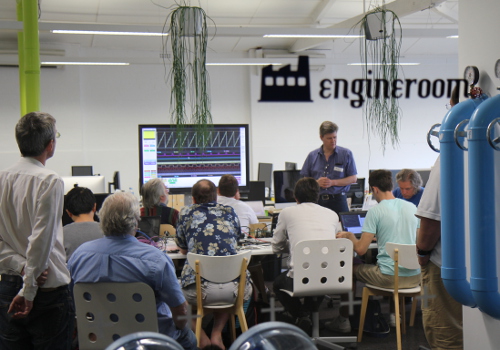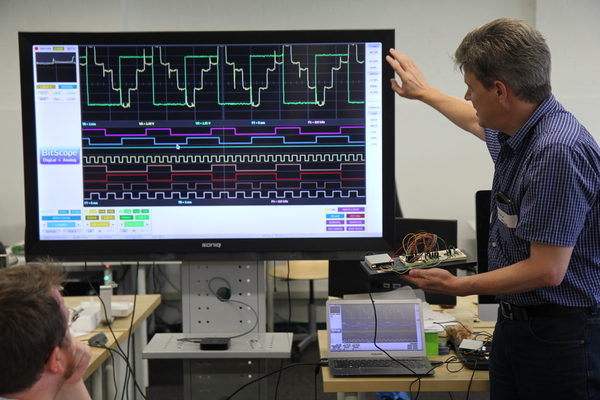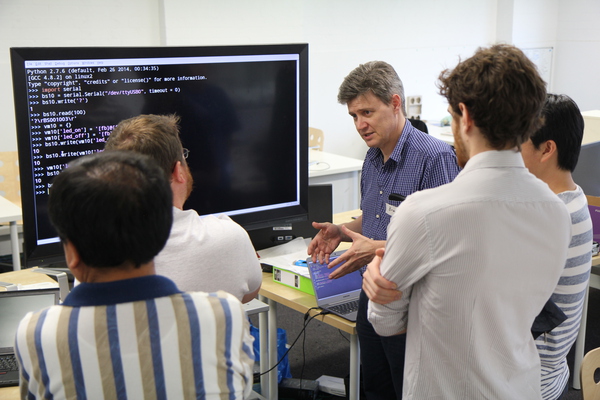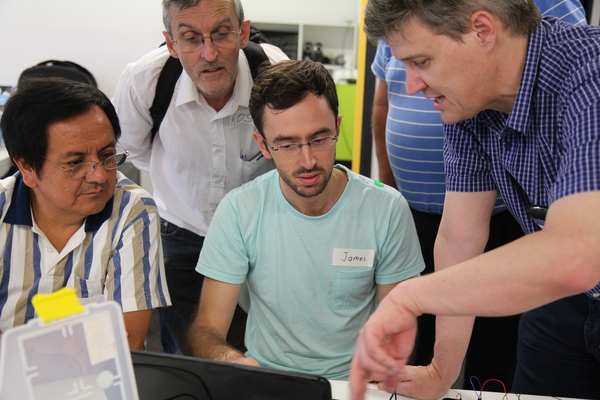
Bruce presenting at the OzBerryPi BitScope Workshop (slides)
2014-04-08

Bruce presenting at the OzBerryPi BitScope Workshop (slides)
We were delighted to be invited back to engineroom on Sunday to present a BitScope Workshop for OzBerryPi.
A few months ago we presented a seminar on BitScope Ed to explain our thinking about project based learning, especially in the context of online education delivery.
We discussed in general terms about how BitScope can bridge the gap between the online virtual and physical worlds. This time we drilled down into the detail of what this means in practice.
We demonstrated how BitScope can be used for test, measurement and data acquisition and how this can be used in education, especially when learning how to program physical computing environments like Raspberry Pi and Arduino or when working with real electronic circuits and systems.
This is especially relevant in the context of real-world mixed signal systems, sensors, servos, robotics and other elements of physical computing that increasingly pervade modern life. We enjoyed a very receptive audience here at OzBerryPi because for many who attended, this is precisely the environment in which they work!

Bruce presenting a live demonstration of Breadboard One.
Bruce provided a live demonstration of Breadboard One, fully powered, controlled and monitored by a USB connected BitScope Mini. This was to demonstrate how a mixed signal physical computing lab can be built with just some low cost electronics.
Throw in a Rasberry Pi, monitor and keyboard and he explained how easy it is to build a stand-alone Electronic Projects Lab which is ideal for use in the classroom or to build a network connected mixed signal system.
At one point he powered up BitScope driving a DC brushless fan, all served on the LAN via a Raspberry Pi and we watched as members of the audience connected remotely from their PCs and Macs to make some measurements.

Bruce present a live coding demonstration with BS10.
We believe a fundmentally important skill for students to learn these days is how to code. We've presented our ideas on this before in general terms as part of a teacher professional development course (slides).
However, in this workshop Bruce explained with live examples how coding skills for physical computing can be developed with BitScope.
BitScope is based on a simple but powerful virtual machine which can be programmed directly using simple command scripts to perform any of its supported functions immediately and in real-time. It's effectively a fully programmable analysis and synthesis system which can be programmed directly via a USB serial port without the need for special APIs or libraries. Bruce typed in some examples to show just how easy it is to get started.
From a coding perspective BitScope is an ideal tool to learn how to program and analyze the physical world.

BitScope Workshop at OzBerryPi - learning by doing.
We're firm believers in learning by doing so for the rest of the workshop we encouraged everyone to connect up a BitScope to whatever projects they were working on and try it. To help things along we donated another three BitScopes to the group and we were on hand to help explain and demonstrate how to "do stuff".
We were very impressed with the skills and project ideas people were working on. It seems we were talking to the right audience because the questions and ideas we received around embedded and mixed signal systems showed a high level of interest and engagment with physical computing and STEM education. It's confirmed our view that makers can make good teachers and has convinced us that the time is right for reform in school education. More than ever we believe physical computing, coding skills and a renewed focus on science and technology in education is long overdue!